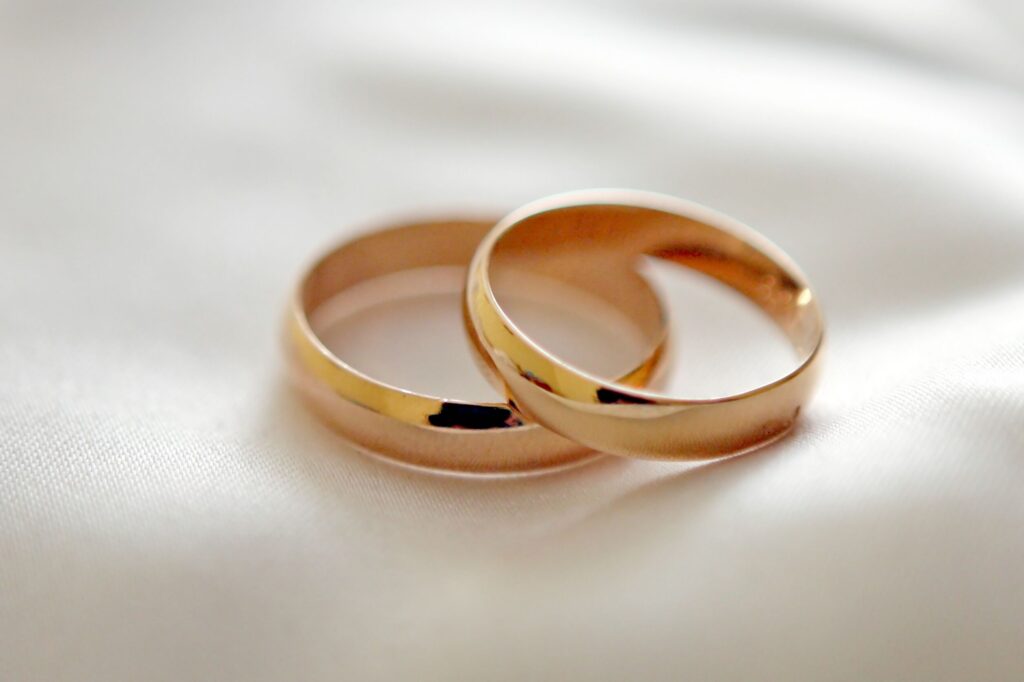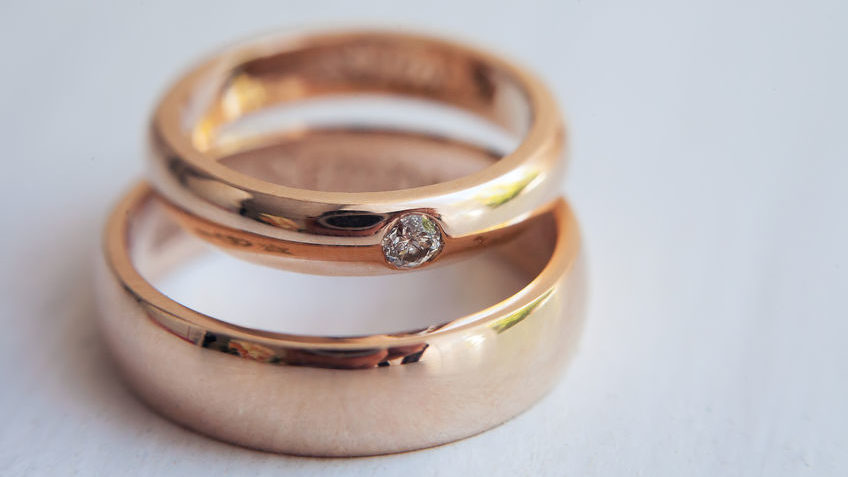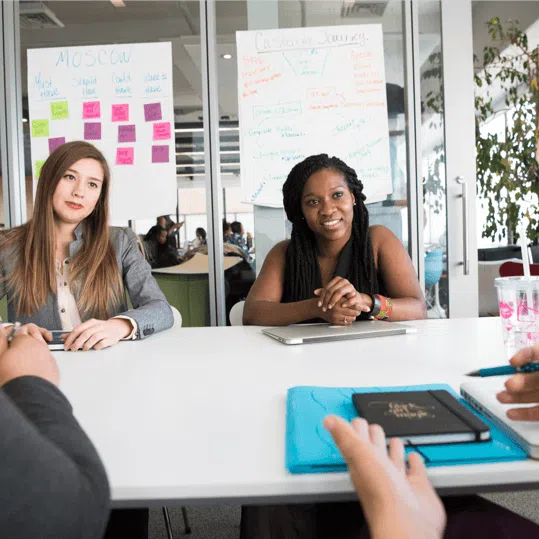We get a lot of questions about the size of wedding bands, and specifically how thick men’s bands generally are.
The thickness of wedding bands can be difficult information to come across, especially because most jewelers don’t consider it to be vital information.
The average thickness of a man’s wedding band is around 2.0mm, but they can range from 1.4 mm-2.5 mm depending on the material, width, and personal preference of the wearer. It is recommended that wedding bands be at least 1.5mm thick for better durability.
Some common follow-up questions include: What is the difference between band thickness and band width? How thick are common wedding bands?
To help you out, here’s everything you need to know about the thickness of wedding bands:

Band Thickness vs. Band Width
Often, the width of the band gets confused with the thickness of the band.
These two terms are not interchangeable, and they actually mean two different things in ring sizes.
Band thickness is how much the band sticks out from your finger, and how thick the material is. In other words, this is the profile view of the ring.
The thickness of a ring indicates how much metal (or other material) was used in making the ring.
On the other hand, the band’s width is how much space the ring takes up on your finger: aka how wide it is.
Band thickness and band width often do correlate, however, the distinction is significant when looking for wedding rings.
Band thickness and band width often relate to each other; the wider the ring is, the thicker the ring will be and vice versa.
Some people like to match the width with the thickness of their ring.
How Thick is an Average Wedding Band?

The thickness of wedding bands depends on the type of material used, the gender of the ring-wearer, and the personal preference of the person wearing the ring.
Men’s Wedding Bands Thickness:
In general, the average men’s wedding ring is around 2.0mm thick, but, depending on the material, it can range anywhere from 1.4mm-2.5mm
Materials:
Titanium: A popular type of metal ring used for men is Titanium. The average size for titanium rings is between 1.8mm and 2.3mm.
However, you can select a thinner ring, ranging between 1.4mm and 1.9mm, or a thicker ring, ranging between 2.2mm and 2.5 mm.
Tungsten: Tungsten is another popular material for men’s rings, and these usually range between 1.5mm-2.3mm in thickness.
Wood: Wood is an alternative to metal rings, and is actually quite popular for men’s wedding rings.
These wooden rings sit at an average thickness of 2mm.
Gold: Gold wedding rings range anywhere from 1.8mm-2.3mm.
However they often are made out of more material due to how delicate the raw gold is, so they average on the thicker side, around 2.25mm.
Combination: Rings with precious metal will often be used with other materials, such as wood and Tungsten.
These combinations range on the thicker side, from 2.0mm-2.4mm in thickness.
Silver: Silver wedding bands are very similar to gold in that they range around 1.9mm in thickness.
Women’s Wedding Bands Thickness:
Women’s wedding bands are, on average, around 1.4mm thick.
They are slightly thinner than men’s wedding rings but usually accompany an engagement ring.
Like men’s, women’s engagement ring thickness depends on the material that is used.
Materials:
Gold: A popular wedding band for women is gold. A 14 Karat gold ring is thicker than the average band, at around 2.3mm thick.
Sterling Silver: Silver wedding bands are another popular choice metal for women’s wedding bands.
These wedding bands range from 1.5mm-2.0mm.
However, silver is a metal that can bend easily, so, although it is less common, you can opt for a thicker band ranging from 2.0-2.3mm.
How Wide are Men’s Wedding Bands?

There are some distinct differences between men’s and women’s wedding bands, but the biggest difference is the width of the bands.
Men’s wedding bands are generally a lot wider than women’s.
This is because men just wear the wedding band, whereas women usually wear their wedding band with their engagement rings and so their bands should be less thick.
The average width of a man’s wedding band is 6mm, but they range generally around 5-8mm.
The width of the band depends on personal preference.
People with thinner, longer fingers typically prefer wider bands because those will flatter their hands.
On the other hand, wide bands can make a person’s fingers appear shorter or more stubby, so someone with shorter fingers might want to opt for a thinner band.
This thinner band will complement their hand and make their fingers look longer.
Wider bands could also get stuck more easily because they cover a larger portion of the finger.
Why Thickness of Wedding Bands Matters:
The size of a ring depends on personal preference first and foremost.
Some people prefer a thinner ring that feels lighter on their fingers, whereas others prefer a more sturdy, thick ring.
The thickness of the ring also determines how much material was used in making the ring.
Different manufacturers make different thicknesses of rings.
There are certain things to consider when choosing the thickness of a ring:
Pros of Thick Wedding Rings:
Thick rings are less delicate than thin rings, which means that they won’t break or wear out as easily.
Therefore, less money will need to be spent on repairs.
Thick rings also won’t bend or warp as easily because they have more metal to reinforce the ring.
It is suggested that wedding bands be at least 1.5mm thick to improve the durability of the ring.
Cons of Thick Wedding Rings:
Thicker rings are heavier on the hand, and some people dislike the feeling that something is in between and separating their fingers.
Thicker rings were made with more material, and therefore they are more expensive to buy.
They also can get in the way of day-to-day activities and scrape against things quite frequently.
However, thick rings are more rigid and less flexible on your fingers to adjust to slight changes.
Pros of Thin Wedding Rings:
Thin rings are less likely to interfere with day-to-day activities, and they may be more comfortable to those who don’t like the feeling of something between their fingers.
Thin rings are also more flexible and can adjust to your hands better if you gain/lose weight or have slight swelling.
Cons of Thin Wedding Rings:
Thinner rings have less material on them, so they are more likely to get bent out of shape or to wear out.
This means that with a thinner ring you will have to be more careful and spend more money on repairs.


